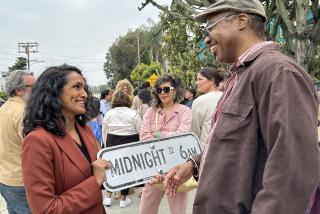On Silver Lake’s ‘Walking Man’
- Share via
Until July 21, when he was found dead in his home hot tub, Dr. Marc Abrams walked roughly 20 miles a day throughout the Los Angeles neighborhood of Silver Lake. Just about anyone who spent any amount of time there knew him by sight if not by name. Usually shirtless, the Silver Lake “Walking Man” was lean, preternaturally tan and often stiff-gaited. He almost always carried reading materials; a folded newspaper or a magazine or, at night, a book he’d read with the aid of a flashlight. Since moving to the area in 1980, he had become a fixture, the subject of numerous articles and a documentary film. He was even depicted on two murals on Sunset Boulevard.
He was, in other words, part of the fabric of the neighborhood. And Silver Lake being what it is, that fabric might be described as a blend of numerous materials, chief among them eccentricity and (at least over the last few decades) relative affluence. Abrams’ contradictions and incongruities made him a fitting symbol of the place. He may have been a fitness nut (in addition to walking, he claimed to swim two miles and do 4,000 pushups every day) but he wasn’t exactly a health nut. He was quoted as saying he had “six basic food groups: cookies, cakes, coffee, milkshakes, chocolate and pizza.”
More important, he was eccentric, perhaps even a little unhinged (he described his exercising as a “routine,” though surely a case could have been made for obsessive compulsion), but he was also a medical doctor. As mysterious as he was, most locals knew that much.
And perhaps it was that duality — the idea that you could be an oddball and a respected professional at the same time — that caused so many people to feel an affinity for him when he was alive and a sense of loss when he died. It wasn’t just that he’d become a fixture. It was the way one of the chief challenges of 21st century Silver Lake life — the near impossibility of maintaining some semblance of a quirky lifestyle and bohemian identity amid the skyrocketing cost of living there — seemed to be embodied in one (increasingly bedraggled) body.
But, as we now know, Abrams may have had demons that went beyond gentrification-exacerbated existential angst. At the time of his death, which has been ruled a suicide by drowning, he was under investigation for prescribing drugs to a patient who later died of an overdose. Officers posing as patients have said they were easily able to get powerful prescription drugs from Abrams and that he catered to addicts. Abrams kept nighttime hours until he closed his Valley Village office last year.
Blogs and comment boards are exploding with chatter about the new revelations, but there are still many admirers who describe Abrams as a legend and an inspiration, as well as former patients who have rushed to his defense. There’s an initiative to rename the jogging path around the Silver Lake reservoir the Marc Abrams Memorial Loop, and a tribute walk on July 25 drew several hundred participants and made national headlines.
Do all these panegyrics smack of false sentimentality? Does glorifying a troubled man whom few people really knew anything about constitute revisionist history more than community spirit? Well, yes, if these displays were simply about the man. But ultimately they’re not. They’re about the neighborhood; and not just this neighborhood but the entire concept of “neighborhood,” especially in the context of cities and towns — and even a nation — that feel increasingly generic in the wake of superstores and strip malls.
That’s because these tributes, heartfelt as they may be, speak less to Abrams’ quirks, or even to the quirks of Silver Lake, than to something even more universal and more poignant: the degree to which “character” has become a rare and precious commodity in American neighborhoods. It’s human nature to want to feel connected to a place, to know that the streets you call home are distinct from streets elsewhere. But such places are harder and harder to come by. Considering the price people are now willing to pay to live in such neighborhoods, Silver Lake prime among them, it makes sense to honor the characters behind that character — even if parts of them don’t line up with the story we want to hear.



